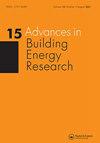Passive ambient comfort and the interaction of vernacular strategies and devices in arid zone habitat design: case of Biskra, Algeria
IF 2.5
Q2 CONSTRUCTION & BUILDING TECHNOLOGY
引用次数: 3
Abstract
ABSTRACT Up until the industrial revolution, energy consumption was relatively linear, and almost exclusively renewable. The exponential industrial and economic development that began with the industrial revolution became increasingly energy-intensive, and since the switch to fossil fuels that energy consumption has been based on non-renewable resources. Satisfying the energy needs of the present without harming future generations remains a complicated problem, especially at the habitat level. This article proposes a methodology for building designers, building upon research on converging towards a global optimum, more specifically, it investigates the feasibility of integrating mezzanines and vaults as vernacular devices to improve the energy performance of buildings in arid zones, while to ensuring the comfort of the occupants. This level of comfort and energy performance is based on the morphological structure of the proposed building type. Combined, these devices result in a higher reduction of thermal in energy ratio load of up to 20.84%. These reductions in energy needs were achieved by applying the methodology developed for the architectural design of a building located in Biskra, Algeria, a design that takes into account both the comfort aspects of the occupants and the need for reduced energy consumption.干旱区栖息地设计中的被动环境舒适与乡土策略和设备的相互作用:阿尔及利亚比斯克拉的案例
在工业革命之前,能源消耗是相对线性的,而且几乎完全是可再生的。从工业革命开始的指数级工业和经济发展变得越来越能源密集型,自从转向化石燃料以来,能源消费一直基于不可再生资源。在不伤害后代的情况下满足当代人的能源需求仍然是一个复杂的问题,特别是在生境一级。本文为建筑设计师提出了一种方法,建立在对全球最佳化的研究基础上,更具体地说,它研究了将阁楼和拱顶作为本地设备集成的可行性,以提高干旱地区建筑的能源性能,同时确保居住者的舒适度。这种舒适度和节能性能是基于拟议建筑类型的形态结构。结合起来,这些设备导致更高的热能比负荷降低高达20.84%。这些能源需求的减少是通过应用为位于阿尔及利亚比斯克拉的一座建筑物的建筑设计开发的方法来实现的,这种设计既考虑了居住者的舒适方面,也考虑了减少能源消耗的需要。
本文章由计算机程序翻译,如有差异,请以英文原文为准。
求助全文
约1分钟内获得全文
求助全文
来源期刊

Advances in Building Energy Research
CONSTRUCTION & BUILDING TECHNOLOGY-
CiteScore
4.80
自引率
5.00%
发文量
11
 求助内容:
求助内容: 应助结果提醒方式:
应助结果提醒方式:


